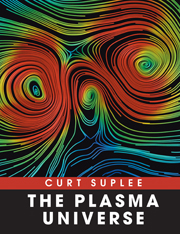The Plasma Universe
Plasma physics is the fascinating science behind lightning bolts, fluorescent lights, solar flares, ultra-bright TV screens, fusion reactors, cosmic jets and black hole radiation, to name but a few examples. Research into this could lead to a source of unlimited, non-polluting energy. Yet plasmas obey their own, often very surprising, rules, and repeatedly defy our best efforts to anticipate and control them. This richly illustrated, full color book reveals for the first time the exciting world of plasma physics to a non-technical audience. It describes the phenomena, and follows the worldwide research effort to comprehend them, taking the reader on a journey from neighborhood neon lights to the remotest galaxies and beyond. The lively writing is interspersed with fascinating photographs and explanatory diagrams, giving the readers a deeper understanding of the world around them.
- Describes the phenomena of plasma physics, a potential source of unlimited, non-polluting energy
- Explores the fascinating world of plasma physics, from neighbourhood neon lights to the remotest galaxies and beyond
- Richly illustrated in full colour, with fascinating photographs and explanatory diagrams
Reviews & endorsements
'In The Plasma Universe Curt Suplee explains in an entertaining way and in educated layman's terms what constitutes plasmas, their complex behavior, the history of plasma science right up to the use of plasmas in modern day and future technologies. In these pages is a concise summary of our current understanding of strange and beautiful phenomena on earth and in stars and galaxies around us. The American Physical Society celebrated the fiftieth anniversary of its Division of Plasma Physics in 2008, and the Division has outdone itself in sponsoring and editing this book, which I recommend for anyone who likes to look at beautiful pictures and who might be interested in the history of science and the process of discovery and innovation.' Cherry Murray, Dean, Harvard School of Engineering and Applied Sciences, and President, American Physical Society
'The Plasma Universe is a lively, compact, beautifully illustrated and eminently readable exposition of the amazing scope of modern plasma physics. The common phenomena underlying plasma TVs, sunspots and the violent death of stars are lucidly explained at level suitable for a broad audience. I particularly liked the onepage profiles of the scientists who shaped the subject, starting with Irving Langmuir, that are sprinkled throughout the text: they provide welcome historical context and human interest.' Curtis Callan, Professor of Physics, Princeton University, and President-Elect, American Physical Society
Product details
September 2009Paperback
9780521519274
88 pages
246 × 189 × 6 mm
0.26kg
72 b/w illus.
Unavailable - out of print
Table of Contents
- Preface
- 1. The fourth state of matter
- 2. The music and dance of plasmas
- 3. The Sun-Earth connection
- 4. Bringing the Sun to Earth: the story of controlled thermonuclear fusion
- 5. The cosmic plasma theater: galaxies, stars, and accretion disks
- 6. Putting plasmas to work
- Index.







